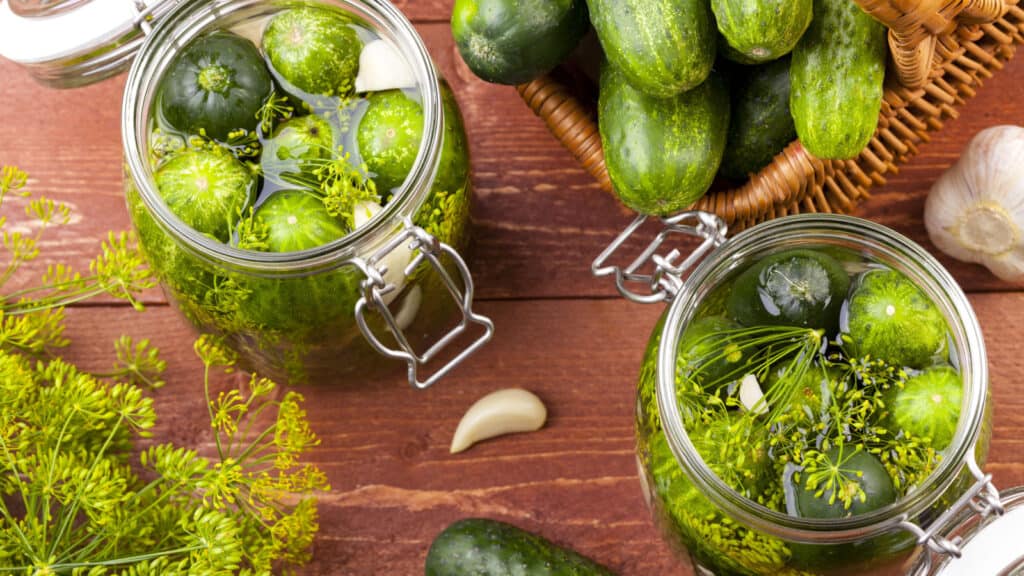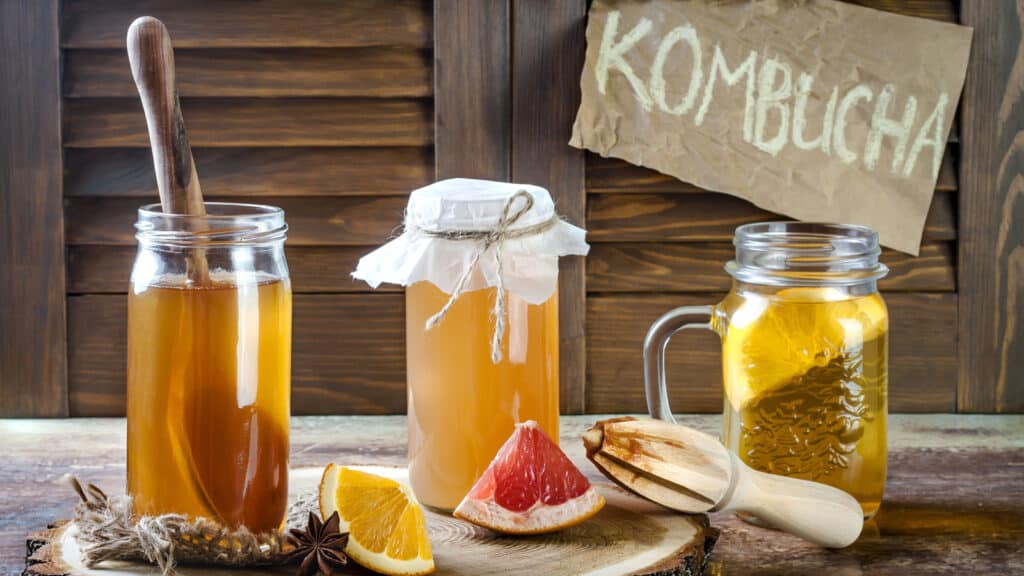Unlocking the Power of Fermented Foods for Gut Health
More people are increasingly mindful of their health, with a growing interest in understanding the role of the gut microbiome in promoting overall well-being. The consumption of fermented foods has garnered considerable attention as a way to support a healthy gut ecosystem. The idea of “fermented” foods might seem odd at first, but most of us are familiar with traditional pickles, and yogurt, to name possibly the two most common fermented items in the supermarket, and perhaps your own refrigerator.
Fermentation is an age-old practice, dating to around 10000 BC, and yet recent market analysis has shown it is as popular as ever, with the global fermented food market reaching over $600 billion in 2022 and a growth rate of over 5%.
There is a diverse array of fermented foods that have the potential to transform and enhance your gut health – and to bring flavor to your meals.
What Are Fermented Foods?

The process of fermentation involves the transformation of sugars and carbohydrates in foods by beneficial bacteria, yeasts, and other microorganisms. This process not only enhances the flavor and texture of foods but also increases their nutritional value, and can extend the food’s shelf life.
As an example, a live bacterial culture is added to milk to create yogurt, which takes on a new flavor and texture, far beyond what the original liquid milk provided.
Fermented Foods and Your Gut Health

According to Dr. David S. Ludwig, a professor of nutrition at the Harvard T.H. Chan School of Public Health, the digestive tract is bustling with approximately 100 trillion bacteria and other microorganisms. Recent research sheds light on the significance of maintaining a diverse and healthy intestinal microbiome, which plays a pivotal role in regulating the immune system and preventing harmful inflammation within the body. Such inflammation has been linked to a range of conditions spanning from obesity and diabetes to neurodegenerative diseases.
Why You Should Eat Fermented Foods

As research progresses, it is anticipated that more insights will emerge regarding the contributions of the microbiome to overall health. This knowledge could potentially lead to the identification of specific microorganisms capable of targeting diseases or aiding in weight loss efforts. In the meantime, Dr. Ludwig suggests that fermented foods offer a practical solution. By supplying a variety of probiotics, fermented foods support the development of a resilient microbiome in the digestive tract, thereby helping to fend off detrimental elements.
Vegetarians & Vegans Take Note: Bring On The Nutrients!

Vitamin B12 is not naturally present in plant foods, but the bacteria introduced to create fermented foods such as sauerkraut or kimchi yields a dish with B12! Another great reason to add these foods to your diet.
Yogurt: A Creamy Classic

Yogurt, a beloved source of protein, calcium, vitamins, and probiotics, stands as a staple in dairy products, boasting gut-friendly bacteria. Recognized for its role in preventing chronic illnesses, yogurt comes in a variety of dairy and non-dairy options, each offering creamy texture and nutritional benefits.
According to FDA standards, yogurt must contain S. thermophilus and L. bulgaricus to be considered yogurt. Some yogurt brands display a “Live & Active Cultures (LAC)” seal from the National Yogurt Association (NYA). This certification is voluntary and indicates that the yogurt contains at least 100 million cultures per gram at the time of manufacturing. While some yogurts may not explicitly mention the presence of live cultures on the label, multiple brands may still include them.
However, read labels carefully: some yogurts undergo heat treatment, which kills off the cultures, or they may simply add live cultures to the recipe without undergoing the fermentation process necessary for yogurt production. To receive the NYA seal, yogurt must undergo fermentation.
Sauerkraut: A Tangy Triumph

Sauerkraut, a simple blend of cabbage and salt, packs a punch with its probiotic and fiber content.
Its consumption may alleviate symptoms of digestive issues like irritable bowel syndrome (IBS). In a small-scale clinical trial conducted in 2018, researchers examined the effects of both pasteurized and unpasteurized sauerkraut on the gut microbiota of 34 individuals diagnosed with IBS. The gut microbiota, comprising trillions of microbes residing in the gastrointestinal tract, were the focus of this investigation.
Participants from both groups reported a notable decrease in the severity of their IBS symptoms. However, it was observed that only those who consumed unpasteurized sauerkraut exhibited positive alterations in their gut microbiota composition.
Whether homemade or store-bought, refrigerated variants (as opposed to canned and pasteurized) offer the highest probiotic potency.
Sauerkraut is also rich in antioxidants and immune-enhancing compounds, fortifying the body’s defense mechanisms, potentially reducing inflammation and oxidative stress.
While generally considered safe to consume, individuals with histamine intolerance or specific medication regimens should proceed with caution and consult a healthcare provider.
Kimchi: An Ancient Korean Powerhouse

Originating from Korean cuisine, kimchi is a spicy blend of fermented cabbage and vegetables, and typically garlic, ginger and red pepper powder, such as gochugaru (Korean red pepper). Kimchi is abundant in fiber, vitamins, lactic acid bacteria, minerals and other compounds. Studies showcase its benefits, from regulating lipids to reducing inflammation, stimulating immune function, reducing free radicals, and potentially aiding in reducing obesity.
Enjoy kimchi as a condiment or standalone dish for its complex flavors. We have a recipe for you.
Kefir: Yogurt’s Lesser Known Cousin

Kefir, a fermented milk drink similar to yogurt, has a creamy texture and is known for its probiotic content. It is made by adding kefir grains to cow, goat, or sheep milk. These grains (shown on spoon above) contain beneficial yeast and bacteria that ferment lactose into lactic acid, giving kefir its tangy flavor and nutritional content.
Kefir contains approximately 12 active probiotic strains (typically more than yogurt), which support gut health by promoting a balanced microbiome. It is rich in calcium, vitamin D, phosphorus, magnesium, and vitamin K, aiding in maintaining strong bones. It has antimicrobial properties to help combat harmful bacteria, bolstering the immune system.
Studies suggest that kefir consumption may help manage blood sugar levels, particularly beneficial for individuals with Type 2 diabetes; more studies are needed.
Adding kefir to your daily routine can enhance your overall health. Start with small servings to allow your body to adjust to the probiotics and enjoy the benefits of this nutritious beverage. It is a great smoothie ingredient!
Pickles: Choose the Right Ones

You might think of kosher dills, cornichon, or bread-and-butter pickles when you hear the word “pickles”, but the term”pickles” covers a variety of food items. In order to get the nutritional benefits from fermented pickles, you have to read labels.
Fermented pickles will not include vinegar in their ingredients list but will include salt. They are often labeled as “lacto-fermented” or “naturally fermented.” “Quick pickles” made with vinegar, do not undergo fermentation (although they can be quite tasty).
Pickles that are fermented contain probiotics, which are beneficial bacteria that support gut health. These probiotics can aid in digestion and contribute to a healthy balance of gut flora.
However, it’s worth noting that pickles can also be high in sodium due to the salt or brine used in the pickling process. Excessive sodium intake can be detrimental to health, especially for those with high blood pressure or heart conditions. Additionally, pickles made with added sugars can contribute to increased calorie intake and may not be suitable for individuals monitoring their sugar consumption.
Kombucha: A Fizzy Fusion

Kombucha is a non-alcoholic, or low-alcoholic, slightly acidic and carbonated drink. It’s made by fermenting sweetened tea with probiotic microorganisms known as SCOBY (symbiotic culture of bacteria and yeast). The production process involves fermenting SCOBY for 7–21 days. Extending the fermentation period enhances the levels of bioactive compounds such as polyphenols, B vitamins, vitamin C, and essential minerals like iron, manganese, zinc, copper, and nickel. Notably, phenol and flavonoid compounds decrease initially during fermentation but progressively increase over time.
The probiotic function of kombucha is primarily attributed to bacteria like Lactobacillus, Bifidobacterium, Bacillus cereus, Propionibacterium freudenreichii, and yeasts from the Saccharomyces genus. Alongside their probiotic role in promoting a healthy microbiome, these microorganisms also produce various beneficial compounds such as amino acids, organic acids, sugars, polyphenols, and vitamins. Additionally, the fermentation process yields other micronutrients that contribute to the potential benefits of kombucha.
Numerous in vivo and in vitro studies, particularly involving animals and more recently humans, have highlighted the diverse health-promoting effects of this product. These effects encompass anti-inflammatory, antioxidant, antibacterial, antidiabetic, anticarcinogenic properties, cholesterol reduction, and enhancements in liver metabolism, immune function, and gastrointestinal health.
Exercise caution with unpasteurized options, especially during pregnancy.
Miso: An Umami Marvel

Miso, a traditional fermented food, boasts a distinctive savory flavor and aroma, commonly used as the basis in miso soup. Derived from soybeans and grains through the actions of Koji enzymes and beneficial microbes, miso’s microbial content plays a pivotal role in enhancing its umami-rich flavor, texture, and nutritional value.
Despite the critical role of microorganisms in miso production, research into its nutritional and medicinal potential remains limited, although some studies have shown some level of potential anticancer, antimicrobial, and anti-obesity effects. Miso has also been shown to have the potential to counteract radioactive effects and regulate cholesterol levels in the human body.
Use miso in soups, dressings, and marinades for its distinctive taste. We have a Miso Lime Glazed Salmon recipe for you that is an easy weeknight meal.
Tempeh: A Nutty Revelation

Tempeh, a traditional Indonesian delicacy, has health benefits supported by rigorous scientific investigation. Tempeh’s unique fermentation process incorporates beneficial microorganisms, notably Rhizopus species. This fermentation not only enhances the bioavailability of nutrients but also imparts distinctive flavors and textures to the final product, which for some is an acquired taste. It can almost have a nutty flavor at times.
Notably, tempeh has been shown to improve lipid profiles, potentially reducing the risk of cardiovascular diseases. Furthermore, its fiber-rich composition promotes digestive health and aids in weight management. Tempeh is also a rich source of essential vitamins and minerals, including B vitamins, iron, and calcium, essential for overall well-being.
Beyond its health attributes, tempeh shines as a sustainable and affordable protein source. As a plant-based food, tempeh boasts a minimal environmental footprint, making it an eco-conscious choice for conscientious consumers. Its affordability further enhances its accessibility, making wholesome nutrition attainable for individuals across diverse socioeconomic backgrounds.
Use tempeh in a variety of dishes, from bowls to stir-fries, or try this classic Gado-Gado.
The Takeaway

Fermented foods offer a range of probiotic benefits, promoting digestive health and overall well-being. Incorporate these foods into your diet to enhance and expand your food choices and support a balanced gut ecosystem.
You May Want To Read:
- 26 Plant-Based Recipes For People Who Hate Vegetables
- This Is Why You Can Eat Bread In Europe Without Bloating But Cannot In The United States
- Umami: The Fifth Taste Sensation
Our Favorite Cookbooks for Fermented Vegetables & Pickles
This post may contain affiliate links. Please see our disclosure policy for details.
Last update on 2025-07-07 / Affiliate links / Images from Amazon Product Advertising API









